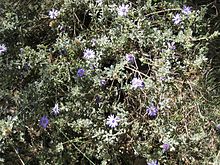- Olearia astroloba
-
Olearia astroloba 
Conservation status Scientific classification Kingdom: Plantae (unranked): Angiosperms (unranked): Eudicots (unranked): Asterids Order: Asterales Family: Asteraceae Tribe: Astereae Genus: Olearia Species: O. astroloba Binomial name Olearia astroloba
Lander & N.G.Walsh[1]Synonyms - Olearia sp. Nunniong
Olearia astroloba, commonly known as Marble Daisy-bush, is a rare shrub species in the family Asteraceae. It is endemic to the state of Victoria in Australia.
Contents
Description
The species grows to 0.5 metres high and has grey-green leaves that are about 18mm long and 10 mm wide. It has "daisy" flowerheads comprising mauve ray florets and yellow disc florets. The peak flowering period in the species native range is between June and July although flowers continue to appear until March.[2]
Taxonomy
The species was first formally described in 1989 in the journal Muelleria based on plant material collected from Marble Gully in 1988. Prior to this, it was informally known as Olearia sp. Nunniong.[1]
Distribution and habitat
The species is restricted to Marble Gully, near Mount Tambo in East Gippsland. It grows on skeletal soils on steep north-facing slopes at an altitude of about 600 metres above sea level. Associated plant species are Allocasuarina verticillata, Eucalyptus nortonii, Pomaderris oraria subsp. calcicola, Ozothamnus adnatus and Themeda triandra.[2]
Conservation
Olearia astroloba is listed as "vulnerable" under the Commonwealth Environment Protection and Biodiversity Conservation Act 1999 and "threatened" under the Victorian Flora and Fauna Guarantee Act 1988. The total population is estimated to be 1,030 plants within a 40 hectare area. Potential threats include inappropriate fire regimes, weed invasion, grazing by stock and rabbits and mining for marble.[2]
Cultivation
The species prefer a well-drained position in full sun or part shade. It is able to withstand drought and moderate frost. Pruning promotes new growth and increased flowering. Propagation is by cuttings or seed, though a large percentage of the latter is often non-viable.[3]
References
- ^ a b "Olearia astroloba". Australian Plant Name Index (APNI), IBIS database. Centre for Plant Biodiversity Research, Australian Government, Canberra. http://www.anbg.gov.au/cgi-bin/apni?TAXON_NAME=Olearia+astroloba. Retrieved 3 August 2011.
- ^ a b c Carter, Oberon; Neville Walsh (November, 2006). "National Recovery Plan for the Marble Daisy-bush Olearia astroloba". Department of Sustainability and Environment (Victoria). http://www.environment.gov.au/biodiversity/threatened/publications/pubs/o-astroloba.pdf. Retrieved 3 August 2011.
- ^ Busby, Nicole. "Olearia astroloba". Growing Native Plants. Australian National Botanic Gardens. http://www.anbg.gov.au/gnp/interns-2007/olearia-astroloba.html. Retrieved 3 August 2011.
Categories:- EPBC Act vulnerable biota
- Olearia
- Flora of Victoria (Australia)
Wikimedia Foundation. 2010.

